Olympia, Peloponnese, Greece 1/2014
Arriving at the historic town of Olympia, the original home of the Olympic Games, Spring was clearly in the air. Flowers were blooming and lemon and orange trees were overloaded and dropping fruit on the ground. Tourist season had not yet begun so we had the place pretty much to ourselves. We found a comfortable campsite (Camping Diana) just a few blocks from the entrance to the site of the ruins.
The actual site of Olympia at first glance looked like Hiroshima after the atomic bomb. Buried under up to 24 feet of alluvial deposits over the centuries it was rediscovered in 1766 and excavations began in 1829.
The first Olympic festival was organized by a King of Elis in the 8th century BC – with tradition dating it at 776 BC. (The Classical Period between the 5th and 4th centuries BC was the Golden Age of the site at Olympia.) From that time on the Olympic games were held every 4 years and acquired a panhellenic character which means that athletes from all Greek City-States participated.
Competing athletes had to be true-born free Greek men. They were required to travel to Elis, the organizing city, one month prior to the games. Here they were carefully screened for their physical ability, health, heritage, and character. They also went through extensive training to make sure they were fit and ready for the fierce competition. Interestingly, they trained and perhaps competed totally nude. The word “gymnasium” derives from the Greek word “gymnos”, which means “naked”.
During training and the events, men would anoint themselves with olive oil, sometimes slightly perfumed, and you can imagine as the dust collected what they might have looked like. Fortunately, the Greeks had invented strigils that were used to scrape off the dust, dirt, sweat and olive oil. There were different shapes of these strigils for different parts of the body and apparently they were used extensively until appropriate soaps were invented.
Women were not allowed to compete nor could they even watch the games. If they broke this prohibition, they were cast down from Mount Typaion. Apparently the Greeks had no idea what they were missing not being able to watch the women’s beach volleyball.
While wandering through the ruins, few buildings could even be identified except by placards. We did stop at Hera’s alter where the Olympic flame is lit ceremoniously every 4th year and there were still a few columns standing here and there. In a tribute to the Classic Olympics, the stadium was the location for the men’s and women’s shot put competition during the 2004 Athens Olympics.
Most of the true relics and art that had been found through extensive excavations were now housed in a nearby museum or had been carted off to the Archaeological Museum in Athens and other cities. Many beautiful marble statues were displayed in the on-site Olympic Archaeological Museum, along with an amazing collection of other artifacts including interesting pottery and Olympic game components that had survived. The photos below may give you a glimpse.
- The owners of Camping Diana were very friendly. As a welcome she brought us oranges and homemade cookies. 90-year old Thercidides Kosmopoulos is apparently a famous Greek author.
- Arriving in Olympia, Spring was clearly in the air. Flowers were blooming and lemon and orange trees were overloaded.
- At first glance the Olympia ruins looked like Hiroshima after the atomic bomb.
- Few buildings could even be identified except by placards. We could only imagine its former magnificence.
- The great Temple of Zeus, built in 470 BC, was home to the imposing statue of this all-powerful God.
- The Olympic Festival and Games were held in Zeus’ honor.
- The Temple of Zeus contained a 12-meter tall gold and ivory statue of Zeus perched in his ebony throne. It was considered to be one of the Seven Wonders of the Ancient World. Holding a scepter in one hand and Nike in the other gave clear expression to Zeus’s role as Lord of the World, Preserver of Law and Order, and Judge of all contests on Earth.
- The Philippeion, a circular building begun by Philip II, King of Macedonia, after the battle of Chaironeia, (338 BC), and was completed by his son, Alexander the Great. When finished, it housed five statues of Alexander and his forefathers.
- The Temple of Hera, wife of Zeus, is believed to be the first building constructed in this Sacred Grove called Altis (600 BC).
- The Olympic flame of the modern-day Olympic Games is lit by reflection of sunlight in a parabolic mirror in front of the Temple of Hera and then transported by a torch to the place where the games are held.
- The Baths were built in the 5th c. BC and modified in later periods.
- Intricate brick and stonework gave an impression of the attention to detail and art that was evident at Olympia.
- “The Crypt” was a vaulted passageway linking the Altis with the Stadium. It was built at the end of the 3rd c. BC.
- The Stadium where the Olympic Games were held was 212.54 meters long and 28.5 meters wide. There were no seats but the embankments could accommodate 45,000 spectators.
- Gary refused to run the 200-meter dash nude.
- Strigils were used to scrape off the dust, dirt, sweat and olive oil. There were various shapes of these strigils for different parts of the body. Try one next time instead of a shower!
- The Olympic Archaeological Museum exhibited an amazing collection from different periods of beautiful pottery that had somehow survived.
- Beautiful wall and floor mosaics had been discovered and carefully moved to the museum.
- Examples of bronze work like this eagle’s head and a warrior’s face shield were among many treasures found during excavations.
- A priestess of Demeter name Regilla, wife of Herodes Atticus, offered this bull statue to Zeus (2nd century AD).
- Hermes, messenger of the Gods, was charged by Zeus to take the infant Dionysos to the Nymphs where they were to nurse him. Hmm; we wonder what they fed him since he is the God of Wine…..
- These marble figures were part of the East and West Pediments of the Temple of Zeus and depict scenes from the mythological battle of Lapiths and Centaurs and the chariot race of Pelops and Oinomaos. Don’t ask us to explain.
- As we had seen in Portugal’s Mafra Cathedral, (see Mafra, Portugal blog), we were astounded by the details of this marble statue, probably of Poppaea Sabina, second wife of Nero as a priestess. Note the folds of the robe and the hair. Too bad she never met David, (see Florence, Italy blog).



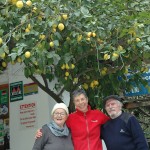
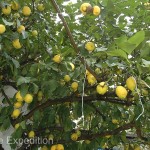

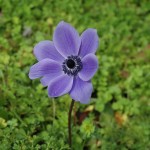


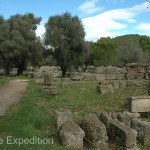
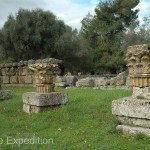






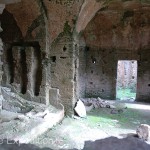
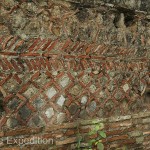
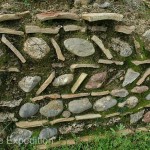
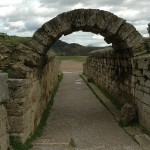

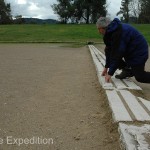
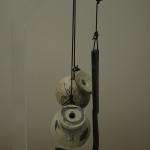
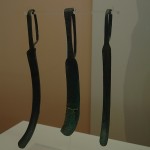

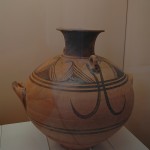
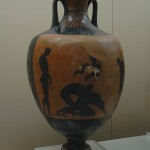
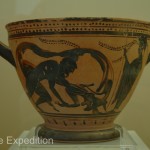




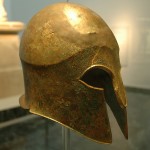
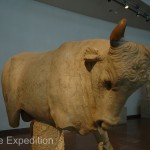

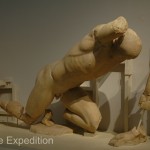


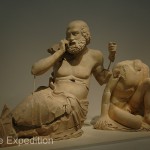
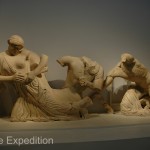

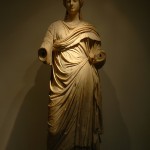
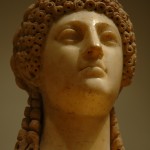
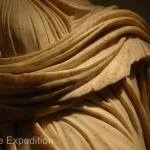





Arriving at the historic town of Olympia, the original home of the Olympic Games, Spring was clearly in the air…. http://t.co/6EwedrkOpe
RT @TurtleExp: Arriving at the historic town of Olympia, the original home of the Olympic Games, Spring was clearly in the air…. http://t…